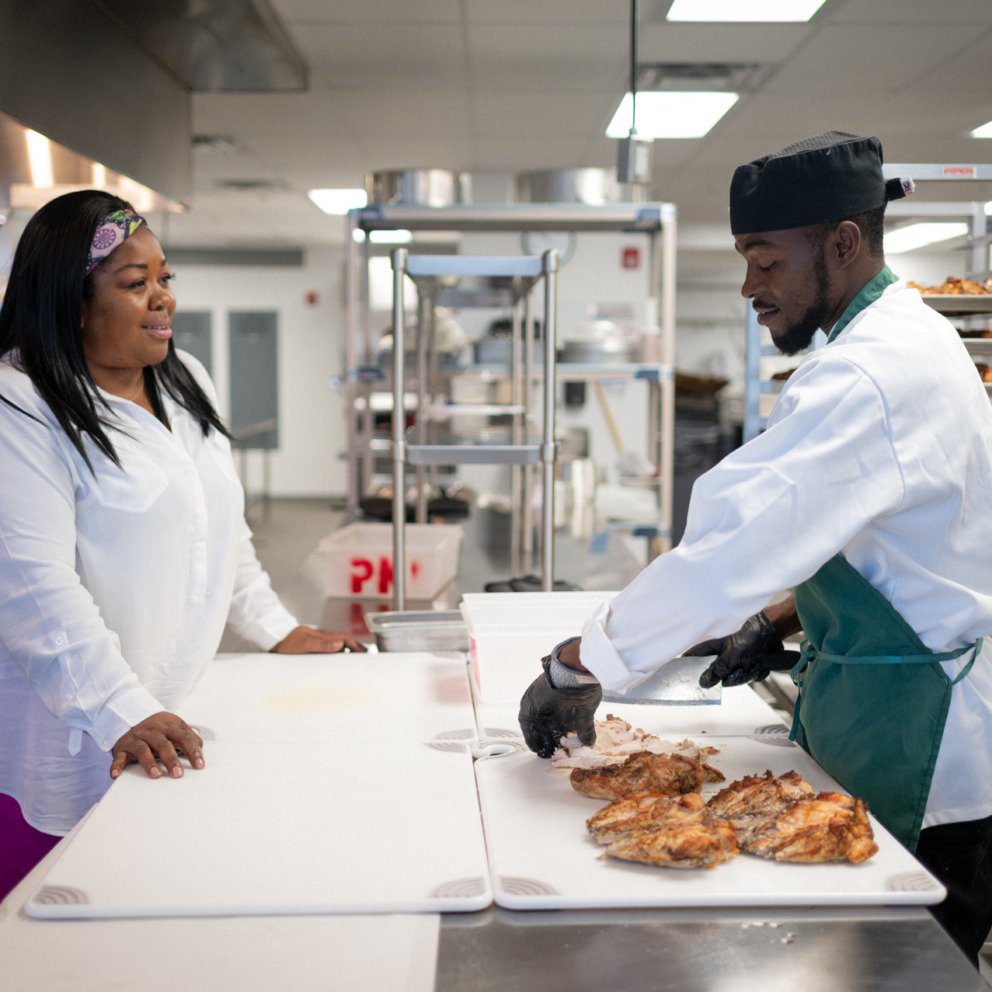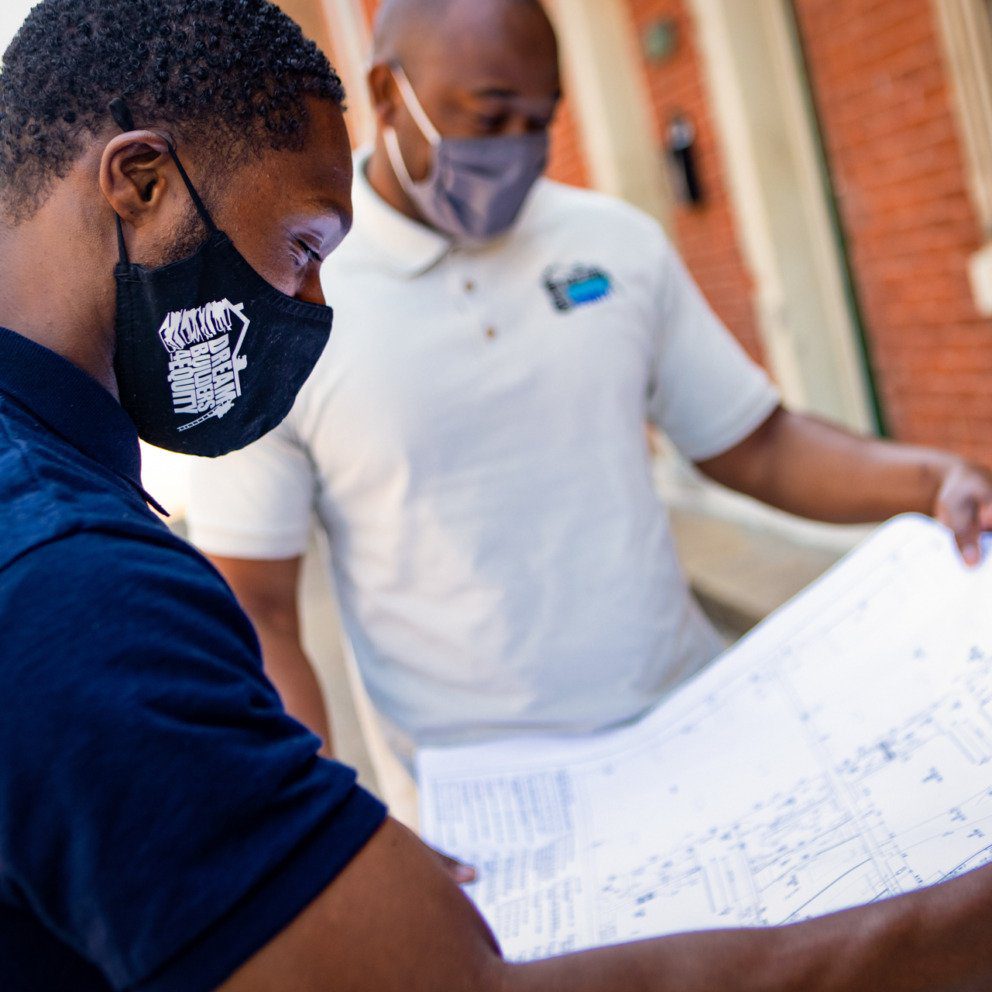Trading Up
As part of the Missouri Works Initiative, the Building Union Diversity program is expanding access to careers in construction.
When Aurora Bihler decided to pursue a career as a union iron worker, she didn’t know where to start. Originally from Joliet, Illinois, she came to the St. Louis area to study fine art and sculpture at Southern Illinois University Edwardsville. After graduating, she searched for a career where she could put her creativity to work and get her hands dirty while still making a good living. The idea of working with iron was intriguing, but she had no family or friends in the construction trades to give her advice or direction on how to pursue that career.
“When I first got into the trades it felt like I was an anthropologist dropped into a foreign country,” she says. “It was like ‘How do I survive and respect this culture? I don’t speak the language, this is all new to me.’”
Bihler’s experience isn’t unique. Each construction trade has its own apprenticeship process, and trade unions haven’t always had the reputation of being the most welcoming of places, with underrepresented minorities and women making up just 6 percent of the construction workforce. While Bihler did go on to find success in her career as an iron worker, she’s now part of the effort to make it easier for others to enter trade careers in St. Louis through the Building Union Diversity program.
BUD’s union construction pre-apprenticeship program was born in 2014 with the goal of getting more St. Louisans into the construction trades, focusing specifically in expanding diversity within those fields. It’s part of the Missouri Works Initiative, a nonprofit whose goal is creating economic opportunities for Missourians.
“It’s important for our union workforce to look like the neighborhoods they work in,” says Jake Hummel, president of the Missouri AFL-CIO (a federation of unions affiliated with the national American Federation of Labor – Congress of Industrial Organizations), which sponsors and supports the Missouri Works Initiative.
To create the BUD program learning materials, several trade unions came together to craft a comprehensive curriculum. It covers basics in construction, math, blueprint reading and tape measure reading, as well as soft skills helpful to launching a successful career.
“The curriculum also covers some life skills about how to have a good attitude at work and how to present well in an interview,” says Megan Price, executive director of the Missouri Works Initiative. “Then throughout the cohort, we’re also taking them to the various apprenticeship training centers. And that is what students really find to be the most exciting part of the course.”
The six-week BUD program is held four times a year at no cost to students, and gives participants a taste of all the building trades so they can find which one suits them best. In addition to hands-on sessions with carpentry, bricklaying, electrical, sheet metal, plumbing and pipefitting, and cement masonry, BUD also focuses on wellness and personnel issues, with classes on subjects from financial literacy to fighting racial and sexual discrimination on the job site.
“The benefit of a cohort is that we continue to find that the model of bringing students together to go through this similar experience creates a lot of synergy, a lot of organic connections for people who are also starting their career and maybe encountering challenges,” says Price. In addition to building networking connections, the cohort also helps establish a peer support system – one way to help combat the high rates of mental health issues among construction workers.
The first week of BUD is a full five days, but the remaining weeks are only four days long, giving students time to work or take care of getting the documents together they’ll need for their apprenticeship, like birth certificates and social security cards. Students also receive a $100 weekly stipend to help with expenses, and they’re supplied with necessary equipment like boots, high-visibility shirts and vests, work pants, ear and eye protection and a hard hat so they can hit the ground running once the program is completed. Transportation to the various training locations is also provided. Once a BUD graduate is accepted into an accredited apprenticeship program they get a $150 tool stipend as well.
Since its inception, 92 percent of BUD participants have graduated from the program, with 26.5 percent of those graduates being women and 79.2 percent being underrepresented minorities. One of those graduates is Raine McDevitt, who completed the program in November 2022.
“I went to a local private high school and they were like ‘You go to college, you get your fancy degree and you make a lot of money so you can give it back to us,’” says McDevitt. “I wish I’d known about BUD earlier.” McDevitt has a degree in graphic art and tried her hand in that field, then gave coding a shot, all the while supplementing her income with bartending and serving jobs. She heard about the program from a BUD graduate she met at a Women In The Trades meeting and decided to apply.
“I consider BUD one of the best decisions I’ve ever made,” says McDevitt, who now works as a tile finisher with Stutte Tile Flooring.
Another crucial part of the program is to give students an overview of all of the trades so they can get a clear picture of which one would be best for them. Bihler plays a key part in mentoring the students to help them find the right career path.
“I think the BUD program did a great job of painting that picture overall,” says Shay Jones, who graduated from the program with McDevitt. “You feel informed and responsible for your decision.”
Jones spent years behind a desk in the home health care industry, while longing to be in a role where she could tap into her creative side. She found her fit as a glazier apprentice with Industrial Walls & Roof North America.
“I’m a baker, and caulking reminds me a lot of icing,” says Jones. “So I found it really easy to work with. I wanted to do something more hands-on, and something where I could see results of my work immediately, something more visible and tangible.”
Jones was also attracted by the competitive wages and benefits trade unions offer. According to the U.S. Bureau of Labor Statistics, there’s about a $10,500 net difference between typical trade union and non-union annual salaries.
Once participants find a trade to pursue, often the biggest hurdle they face is finding out how to start the process to become an apprentice. One of the main focuses of BUD is to help students navigate those waters.
“I’d always been interested in the trades, but I didn’t know anything about that world,” says Jones. She feels BUD was invaluable in helping her figure out the necessary steps to successfully apply for her apprenticeship.
Bihler strives to help students realize they have what it takes to succeed in the trades, regardless of their background, and to advocate for themselves, using her own experiences coming up through the union ranks as an example.
“I felt like I was constantly standing up for myself or for other people who did not fit the mold,” Bihler says.
“Now I tell my students, ‘You need to set your limits and don’t let other people do it for you.’”
Join the Story
- Sign up for the next BUD cohort on the Missouri Works Initiative website.
- Read other STLMade stories of organizations helping to build up the metro’s skilled workforce:








